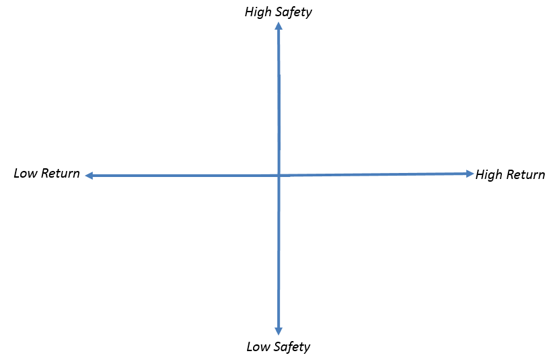Every day – every year, I tell audiences nationwide – on radio, television, in print, and in person, that they need to be paying much more attention to the Three Wealth Killers (Market Risk, Taxes, and Fees/Commissions); and much less attention to the latest whiz-bang strategy to grow their money. In fact, how we grow money is exponentially less important than what we do to tame the Three Wealth Killers – and the market volatility of the last couple of weeks has put the terror of market risk at the forefront of many of our minds.
So why are people still coming up to me asking questions like “What’s going on? “Is this the big one?” “Is this likely to continue?” “Have we seen the worst of it yet?” “What should I do?”
Is it possible that after all these years, my pleas to them have gone unheeded?
Reality is, not everyone believes there is a risk-free way to grow money at a rate that will get them to their financial goals. Most people are locked into Wall Street think – believing that risk and return must necessarily go together. Even more people are just stuck – stuck in lousy 401k plans and other illiquid investments or accounts where the options are few or worse. Many of them have thrown their hands up – hoping somehow they’ll survive the calamity with fewer bruises than the next guy – but resigned that they may not.
That’s no way to live. But human nature is a funny thing. Now, a full 6 years into a market that has done nothing but climb, climb, climb – we forget the feelings we dealt with in 2008 when the market reached its low point – and most of us were some 40% off our financial highs.
Questions to Ask About the Market
So here we are. A frightening drop one day – a rebound the next – and tomorrow – who knows? So while you still have hair and fingernails, let’s hit the reset button and ask ourselves some very important questions. Here are 10 worth considering:
- Am I anxious – or have lost sleep over what’s going on in the markets?
- Am I really as risk-tolerant as my portfolio would suggest?
- How will I feel if the market goes down more?
- How will I feel if markets remain down for a sustained period of time?
- What significant, personal financial events over the next 3 years could force me to lock in losses if I need access to my money (retirement, college, etc.)?
- If my broker says “hang in there – it’ll come back” – what does that mean?
- If my broker says “let’s make some adjustments” – what does that mean?
- If my broker says “buy!” are they just plain nuts?
- What did I do – how did I feel in 2008 when this last happened – and what will/should I do differently this time around?
- If I were to lose my job, do I have a way to cover 6-12 months of living expenses without raiding my 401k and paying taxes and penalty?
If any of these questions turn a little knot in your stomach, it’s time to re-assess your true risk tolerance, and search out alternatives that you might be much happier with over the long run. Take a look at the following graph. Study the axis labels – and put an ‘X’ where you would want to have your money invested given a choice.

Everyone would prefer to have their money invested in something that’s very safe, while at the same time offering them the opportunity of a high return. Is your checkmark in the upper right-hand corner? That’s ‘investors’ panacea.
The Money Contract – A Stock Market Alternative
Let me introduce you to that choice. Something that accomplishes complete safety, while still offering a very good return. It’s called a Money Contract.
If that’s a new term to you, then perhaps you’ll be more familiar with its much less exciting cousin – the bank Certificate of Deposit. People love the safety features of bank CDs, but they don’t get too excited about the returns they offer – particularly over the last decade.
CD’s are the polar opposite of stock markets. With CDs, safety is outstanding, but returns are lousy. With stock markets, safety is non-existent, but the opportunity for returns can be spectacular. A Money Contract combines the best features of both – and eliminates the worst features of both – offering CD-like safety, and market-like returns at the same time.
Interest is credited to a money contract based on the performance of a market index – say the S&P 500, or others. But wait you say – markets can go down! Ah – that’s where the Money Contract shines. Money contracts come with a ‘floor’ earning rate that is never less than zero. Some money contracts even have a floor of 1%, 2%, or even 3%.
In exchange for that complete downside protection, money contracts also come with an upper limit earnings cap. In most cases, caps are in the 12-14% range. When the market index exceeds the cap, earnings credited to the money contract ‘cap out.’
Assuming a floor rate of 0% and a cap rate of 13% – here’s how a money contract would perform in various market conditions:
Actual Market Index Performance Money Contract Earnings Credit
-13.5% 0% (Floor)
+ 9.6% 9.6% (Actual)
+21.2% 13% (Cap)
Money contracts can be tied to any of several different indexes, and the snapshot points can be annual or monthly. They can be adjusted periodically so the owner has flexibility. Most money contracts also offer a fixed rate that is several multiples of the interest rate paid on a bank CD (for the particularly squeamish).
More importantly, it turns out that over almost any time period measured, it is much more important to your financial outcome – to eliminate the losing years – than it is to capture the peaks of the years where the market outperforms the money contract cap.
A Better Way?
Just think about it. How bad would you feel if the market went up 20%, but you only earned 13%? Probably not too bad. Now how good would you feel if the market tanked by 20%, and you never lost a dime? Probably quite good!
Equally important is the ‘lock-and-reset’ feature of money contracts. Once earnings are credited to the contract, they become part of the protected principal and cannot be lost. This is a huge feature. No guessing about when to sell and take profits – or when to sell and stop losses – and then make another guess about when to shove your chips back in.
All the guesswork is eliminated – and by locking out losses and locking in gains, money contract owners uniquely capture the power of compound interest – which Einstein calls the Ninth Wonder of the World.
Five Money Needs
Let me introduce you to the Five Money Needs. These are five things we all – universally – aspire for our money to do and to be. They are:
Safety – we never want to expose our money to the risk of loss
Growth – we want our money to benefit from perpetual, uninterrupted compounding
Income – at some point, we want our money to provide an inexhaustible income stream
Liquidity – we want to be able to get at our money – when we want – without penalty
Tax-Efficiency – we want to minimize or eliminate the impact of taxes on our money
What’s missing off the list? What is on the list that you are willing to give up or live without?
I ask these questions to audiences nationwide every time I speak. There is nothing missing from the list – and there is nothing people would give up voluntarily.
So why aren’t we demanding all Five Money Needs – at the same time – from those who advise us? Why isn’t this simple blueprint the guidepost of more of our saving and investment plans?
Because Wall Street has no answer – and it would not be in their interest to promote a solution if they did. Look back at the graph we considered earlier. If you put your “X” in the upper right-hand corner, ask yourself three more important questions:
- Why is it that I’ve never heard of or been shown a money contract before?
- What alternative does Wall Street – my employer – my advisor – my planner – my brokerage firm offer me, that puts my money in that upper right-hand corner of the safety-return graph?
- If they don’t offer me anything that fits what I want – for MY money – is it time to look outside of Wall Street – is it time to consider another plan of action?
Wall Street is protective of its position as the dispenser of all money-related information. They like monopolizing America’s money. They thrive on market volatility because it produces transaction volume – which generates fees. They invent strategies under the guise of diversification – which are both ineffective, and are only necessary in the face of the very risk they can’t eliminate. Wall Street is also in cahoots with Uncle Sam as they expose money to taxation – a hugely important topic, but one for another day.
Wall Street may get you to the finish line in reasonable shape – but is there a better way? Is there a way that eliminates the Three Wealth Killers – and gives you all Five Money Needs at the same time? Is there a way that gets you there and helps you sleep soundly along the way?
There is. And someone sent you this article because they know that better way. So – now you have a choice. You can keep crossing your fingers – keep glued to the TV ticker to find out whether you should cry or cheer – keep calling your broker for reassurance – keep avoiding the mailbox to see what happened to your money this month – or you can reach out to someone who knows better.
I suggest the latter. We have the answers. We’re here to help. The next move is yours.
Jay Beattey
CEO WealthSmart America





